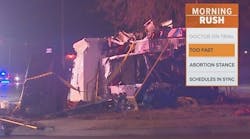In the past year, I have come to know the Keokuk Fire Department (KFD) in Iowa through my friendship with Chief Mark Wessel. Previously, I was familiar with the fire through official documents, but now I have gained much more knowledge of the fire – and the chief, who courageously makes it clear that he was responsible for the fireground and his firefighters that day.
Firehouse® Contributing Editor Steve Meyer and I worked together on this column. Steve reported on the incident, obtained official investigation reports and interviewed Wessel at length. Additional facts and commentary are based on my subsequent discussions and meetings with Wessel.
While we are confident that every “Close Call” we publish teaches significant lessons, there are some that make clear what can happen – and what all of us can do to prevent injury and death to our firefighters. Please read this gripping story as well as our related recommended practices and comments.
On the morning of Dec. 22, 1999, all five of KFD’s on-duty firefighters responded to a car accident. While at the accident, they received another alarm reporting a fire in a two-story, balloon-frame, duplex-style apartment building with victims trapped. The apparatus (a TeleSqurt and a rescue pumper) responded with the shift commander (assistant chief) and a driver on the TeleSqurt (the third firefighter had transported with EMS) and a lieutenant and a driver on the rescue pumper.
Before the crews even arrived at 8:27 A.M., it was already every firefighter’s worst nightmare: a 26-year old woman and her 4-year-old son were standing on a roof, the mother screaming that three more of her children were trapped inside. She had escaped through an upstairs window. (KFD serves 12,000 residents with a full-time career staff of 19 members and covers 10 square miles. Each year, the department responds to 850 to 900 alarms, 60% of which are medical, and 25 to 30 working fires.)
Wessel responded to the incident at 8:31 by first stopping at the hospital to pick up the firefighter who had assisted EMS, bringing the on-duty force to six. Severely understaffed, the firefighters and Wessel had to make critical decisions in an emotionally charged situation when only seconds meant the difference between a heroic, by-the-book rescue and the tragedy that it became.
The fire, caused by combustible materials left on a stove by the 4-year-old child, claimed six lives – three firefighters, toddler twins and their 7-year-old sister. There was a smoke detector in the house, but fire investigators later determined the battery was dead. Just as the chief arrived, he saw the first baby being brought out of the house and handed off to two police officers to transport to the hospital. The firefighters continued searching and Wessel had command. Within minutes, another baby was brought out and handed to the chief, who started CPR. The firefighters went back inside, continuing their searches. No EMS units were available and the nearest EMS mutual aid is 25 miles away; Wessel was faced with a decision.
A police commander asked the chief what needed to be done. Wessel decided the child had to go to the hospital and, with no other resources available, he loaded up in the police car, transported and was back in three minutes. To the veteran chief, the fire appeared to be “routine” – but while he was away, the house flashed over. When this occurred, three firefighters were inside, the lieutenant was on the hydrant and the firefighter he had brought back from the hospital was in front, alone, on the exterior advancing a hoseline.
Three of the five on-duty KFD members died attempting to save those kids:
- Assistant Chief Dave McNally, 48, a 25-year veteran of the department. He was married and had three children.
- Jason Biting, 29, who had been on the department for 61¼2 years and had a wife and three children.
- Nate Tuck, 39, a 41¼2-year member of the department who had a wife and two children.
It would be expected that a fire officer who experienced such a traumatizing event would seek seclusion from the media and probing questions. Wessel, however, remains open about it and eager to share his own and KFD’s views about firefighting philosophy and strategy. The National Institute for Occupational Safety and Health (NIOSH) has released a report on its investigation into the incident. Due to the circumstances of this incident, investigators concluded that fire departments should:
- Ensure that an adequate number of staff members are available to immediately respond to emergency incidents. (Goldfeder – Fire departments can usually “predict” the staffing be it career or volunteer. Now is the time to determine what your staffing is, based upon time of day, response, etc. Is your staffing predictably low? What is your plan to rectify it? Immediate solutions include an aggressive automatic mutual aid and related training program.)
- Ensure that the incident commander (IC) conducts an initial size-up of the incident before initiating firefighting efforts, and continually evaluates the risk versus gain during operations at an incident. (Goldfeder – As in any activity, a plan is critical to a successful outcome. Any fire department can clearly evaluate the risks in its community by looking at response, staffing, equipment and the actual fire flows required to deal with the fire – before the fire – and develop staffing plans and response guidelines to overcome the potential situation.)
- Ensure firefighters are trained in the tactics of defensive search. (Goldfeder – In many areas, the assumption is that all responding members are trained, but many may not be familiar with search tactics. Now is a good time to focus on that training for all members.)
- Ensure that fire command always maintains close accountability for all personnel at the fire scene. (Goldfeder – Accountability is not an easy task, but it is essential. By working in groups with competent company officers using a simple and easy to use accountability system-the risk can be minimized.)
- Ensure that fireground communication is present through both the use of portable radios and face-to-face communication. (Goldfeder – How effective is your radio communication system? Will it work under the worst conditions? Test your system now to insure reliability and plan aggressively before switching to any “new” radio systems.)
- Ensure that a trained rapid intervention team is established and in position immediately upon arrival. (Goldfeder – Who is your rapid intervention team? How many rapid intervention team firefighters are available? Have they had rapid intervention team training? Not every engine or truck company is a rapid intervention team. Training makes the difference.)
- Ensure that firefighters wear and use personal alert safety system (PASS) devices when involved in interior firefighting and hazardous duties. (Goldfeder – PASS alarms can make a difference – but only if they are used, and when they are not ignored! The PASS alarm has become the “car alarm” of the fire service – no one is paying attention! Typically, members exit a building and “drop their packs,” leaving them to sound the alarms. The result is the “ignored chirping” on the fireground. Members must disable self-contained breathing apparatus (SCBA) when leaving the IDLH (immediately dangerous to life and health) areas so that there are no false activations – and officers must enforce that practice. Then, once the “culture” is changed – when we hear a PASS alarm – it will mean a fireground emergency.)
“There wasn’t anything in the report that myself and my department didn’t realize an hour after we lost our firefighters,” Wessel said. “Whether they be career, combination or volunteer, there are a lot of departments our size and smaller out there, so a lot of my observations are based on departments of that size. We’ve had a lot of questions, like how did it happen? Why did it happen? And what did you do?
“The thing I’ve found from doing the presentations I have about this incident is that a lot of departments are saying, we’re the same as you and trying to operate the same way. The same thing could happen to us. Right from the beginning, after the incident, my firefighters had to pick themselves up, and they did. Then we realized we had to change. We asked ourselves, how do we make things safer?”
It came down to three things for the KFD, according to Wessel:
“Based on our experience we’ve had to take a serious look at our manpower,” Wessel said. “We’ve got good equipment, so that’s not an issue. The city has only so many personnel resources it can commit to the fire department.
“It doesn’t take a rocket scientist to figure out that with only five or six firefighters on duty, you’re pretty limited as far as what you can do. I don’t think that was as clear to us before the incident as it is now. Attempting to do too much with too few personnel is a tragedy waiting to happen.
“We responded the way any other fire department would have, with the safety of our citizens being the first priority. Given the conditions we had, and our limited resources, it put us in a very dangerous situation. I’ve listened to a lot of comments like ‘This was a unique fire.’ I differ with that. We had a room and contents on fire, before the flashover. How different is that? An initial-arriving crew to such a fire from my perspective has three priorities: life safety, ventilation and extinguishment. That can’t be accomplished effectively with only five or six people, according to accepted standards.
“If we had more companies there, the additional resources certainly could have helped, but whether the incident would have had a different outcome or not, I don’t know because everything happened so quickly after our initial arrival. More resources certainly could have lessened the element of risk, that’s for sure. But, when you’re not going to get the 16 or more people we need in order to do things as effectively and safely as possible, the only other option is to adjust the way you operate.
“Prior to this fire, when we looked at life safety, we thought about the public we serve, not necessarily ourselves also. So I think we failed in our philosophy for years in light of our limited capabilities. What it comes down to is that if we look at the life safety, extinguishment and ventilation requirements of a structural fire, with our resources we can’t accomplish them all at the same time.
“There were some problems with size-up and incident management at this incident. The way we operate, our shift commander (assistant chief in rank) functions as incident commander. Our philosophy was the IC could also be a firefighter. Not a very good way to operate! Then I arrived, and within a few minutes I’m handed a 22-month-old baby who needs CPR. I left in a police car with the baby, so the incident command system was dropped again.
“We have transitioned that practice now to where the incident commander is simply incident command only. Their job is to conduct size-up, organize an attack, then manage it. Specifically in our department, I have removed the SCBA from the assistant chief’s seat in the first-due rig. My commitment is to never have an incident again without someone in charge, in command and not becoming involved in operations. If you’re the one in command, you stay in command. Don’t take yourself out of the picture.
“I think what happens with incident management material is that when it comes down through the training manuals, it overwhelms people and they say this won’t work, it’s to big for us etc. In reality what we need to do is adapt it, use only the tools from it that are needed for a particular incident. What it comes down to is the IC needs to make a decision in the size-up as to what function: life safety, ventilation, rescue, etc., is the one that he has the necessary resources available to conduct.
“Basically, we’ve come to the conclusion that if Mom is standing on the front porch screaming that her babies are inside, we try to take the emotion out of the situation and approach it with an attitude like, ‘What do I need to do here to get the babies out safely and send everyone home safe in the morning?’ We’ve transitioned to making ourselves more aware of risk versus gain. You have to realize your limitations and think very differently. That’s difficult for firefighters to do. It’s difficult to realize that we can’t be everything to everyone all the time.”
William Goldfeder will present “Scared Straight on the Fireground” at Firehouse Expo 2004 in Baltimore, July 13-18.
William Goldfeder, EFO, a Firehouse® contributing editor, is a 31-year veteran of the fire service. He is a battalion chief with the Loveland-Symmes Fire Department in Ohio, an ISO Class 2 and CAAS accredited department. Goldfeder has been a chief officer since 1982 and has served on numerous IAFC and NFPA committees, and is a past commissioner with the Commission on Fire Accreditation International. He is a graduate of the Executive Fire Officer Program at the National Fire Academy and is an active writer, speaker and instructor on fire service operational issues. Chief Goldfeder and Gordon Graham host the free and noncommercial firefighter safety & survival website www.FirefighterCloseCalls.com. Steve Meyer, a Firehouse® contributing editor, has been a member of the Garrison, IA, Volunteer Fire Department for 22 years, serving as chief since 1985. He is past president of the Iowa Fire Chiefs Association. Chief Meyer is a graduate of the National Fire Academy’s Executive Fire Officer Program, and is a contract instructor for leadership and administration with the NFA. In 1998, he was presented the State of Iowa Firefighter of the Year award.




